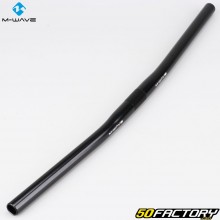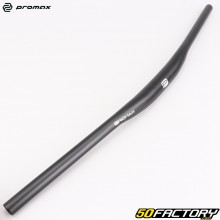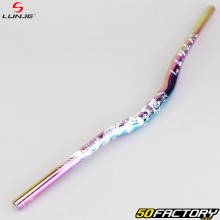 Hanger
Hanger
- IN STOCK30€00
- IN STOCK10€80
-
- IN STOCK16€90
-
- IN STOCK11€00
- IN STOCK8€00
- IN STOCK12€70
-
-
- IN STOCK22€90
- IN STOCK22€90
- IN STOCK34€00
- IN STOCK34€00
- IN STOCK33€90
- IN STOCK21€90
-
- IN STOCK41€20
-
- IN STOCK23€90
- IN STOCK34€00
- IN STOCK34€00
-
Understanding the Importance of Mountain Bike Handlebars
Definition and role
The handlebar, or handlebar, is the bar where the cyclist places his hands to steer the mountain bike. Its main function is to allow the cyclist to control the direction of the bike. It also influences the cyclist's posture and comfort, as well as the handling of the bike on different types of terrain. Its choice and proper adjustment are crucial for an optimal riding experience and can even prevent possible muscle or joint pain.
Impact on comfort and control
A good handlebar can significantly improve comfort and control of the bike. The width, angle and rise of the handlebar all play a crucial role. A handlebar that is too narrow can limit control, while a handlebar that is too wide can tire the arms. Similarly, the angle and rise of the handlebar must be adapted to the morphology of the rider to ensure a comfortable and efficient posture. An ill-fitting handlebar can also compromise the safety of the rider, hence the importance of understanding its purpose and impact.
The different types
The flat model
The flat bar is characterized by aar its lack of vertical curvature. It is often used for bicycles cross-country and marathon because of its lightness and efficiency. A flat bar allows for a more aggressive riding position, which is beneficial for climbs and technical sections. Additionally, it is generally more suitable for shorter riders because of its low height.
The raised model
The raised handlebar, or "riser bar", has an upward and sometimes rearward curvature. This type of handlebar is preferred for more aggressive disciplines such as trail or enduro car It offers a more upright and comfortable riding position, improving control on technical descents and rough sections. It is also more comfortable for taller riders thanks to its extra height.
Other models
There are also other types of handlebars such as the "bullhorn" handlebar or the "drop bar" handlebar which are more specific and adapted to particular uses such as triathlon or road racing.
Materials used in manufacturing
In carbon
Carbon handlebars are lightweight and effectively absorb vibrations, which significantly improves the rider's comfort. They are often chosen forar performance-oriented cyclists. However, they are more expensive and require special attention during installation to prevent cracking. They also have lower impact resistance compared to other materials.
In aluminum
Aluminum hangers stand out for theirar their robustness and offer an ideal balance between weight and durability. They are more affordable, making them a popular choice for a wide variety of mountain bike disciplines. In addition, they are less susceptible to damage during installation compared to carbon handlebars. They are also appreciated for their resistance to corrosion.
In titanium
Titanium handlebars are renowned for their exceptional durability and ability to absorb vibrations. Although they are heavier and more expensive than aluminum or carbon models, they offer excellent comfort and impressive longevity. Titanium is often chosen forar cyclists looking for very high quality equipment and a distinct aesthetic.
Other materials
There are also steel hangers, which are known for their strength and durability, although they are heavier than other types of hangers. Each material has its own advantages and disadvantages, so it is important to choose based on your specific needs and budget.
How to choose the model that suits your needs
Selection based on driving style
The choice of handlebars for your mountain bike must be adapted to your riding style. For the cross-country, a flat hanger may be more suitable due to its lightness and efficiency. For the trail or enduro, a raised handlebar can provide more control and comfort. Also consider the types of terrain you ride most often. The choice of handlebars affects the handling of the bike, so it is important to choose it according to the type of ride you prefer.
Selection based on morphology
The rider's body shape is also a crucial factor. A handlebar that is too wide or too narrow can cause discomfort and decrease control. The height and angle of the handlebar should also match the rider's height and natural posture. It is recommended to test several configurations to find the best fit. Remember to take into account the length of your arms and the width of your shoulders when making your decision.
Additional considerations
Besides riding style and body type, there are other factors to consider. Handlebar material, par example, can influence weight, durability and comfort. It is also important to consider your budget, car Price can vary greatly depending on the type and material of the hanger.
Installation
Preparing for installation
Before you start installing your handlebar, make sure you have the necessary tools: an Allen key or a Torx key, depending on the type of screw on your stem, as well as a torque wrench for final tightening. It is also recommended to wear gloves to protect your hands during the process.
Steps to follow for installation
Installing a handlebar on a mountain bike requires a few basic tools and a little patience. Here are the steps to follow:
- Remove the old handlebar by loosening the stem screws.
- Position the new hanger and adjust it to the desired height and angle.
- Tighten the stem screws gradually and evenly to avoid damaging the handlebars.
- Install the grips, brake levers and gear controls.
- Do a test ride to make sure everything is seated properly and the handlebars are comfortable.
Tips for a successful installation
For a successful installation, be sure to use a torque wrench to tighten the stem bolts to the manufacturer's specifications. This will prevent damage to the handlebar, especially if it's carbon. Also, make sure the brake and gear controls are positioned properly for easy and comfortable access.
After installation
Once the installation is complete, it is important to regularly check the tightness of the screws, especially after the first few rides. Indeed, vibrations can sometimes cause loosening. In addition, if you notice a change in the handling of your mountain bike, it is possible that the handlebars have moved and need to be readjusted.
Care instructions
Tips for regular maintenance
Regular maintenance is essential to prolong the life of your mountain bike handlebar. Clean it regularly to remove dirt and residue. Periodically check the stem bolts to make sure they are tight. If your handlebar is carbon, inspect it regularly for cracks or damage. It is also advisable to avoid leaving your bike exposed to extreme weather conditions, which can accelerate the wear of the handlebar.
Signs that the element needs to be replaced
It’s important to know when to replace your mountain bike handlebars. Signs of wear include cracks, warping, or loss of stiffness. If you experience unusual vibrations or noises while riding, this could indicate a problem with the handlebars. Don’t wait until the problems get worse to take action. Additionally, if you notice a decrease in handling or comfort while riding, it may be time to consider a replacement.
Precautions during maintenance
When maintaining your handlebars, it is essential to be careful not to use harsh chemicals that can damage the material. Instead, use mild cleaners and microfiber cloths to remove dirt without risking scratching the surface. Also, be sure to dry the handlebar completely after cleaning to prevent corrosion. Regular and proper maintenance can help extend the life of your mountain bike handlebars and maintain optimal comfort and performance during your rides.
The offer at our company
The choice available
Within our company, we provide you with a wide selection of mountain bike handlebars, designed to meet all your expectations. Whether you are a fan of cross-country favoring a flat hanger, or fervent of trail requiring a raised handlebar, our catalog will satisfy you. In addition, we offer a variety of models in carbon, aluminum and titanium, in order to provide a suitable response to all needs and all budgets.
The advantages of choosing us
By choosing our company, you benefit from a set of significant advantages. Beyond offering high-quality products at competitive prices, we ensure fast and reliable delivery, wherever you are. In addition, our customer service team, composed of dedicated and expert professionals, is at your disposal to assist you in choosing the best mountain bike handlebar for your specific needs. Finally, to guarantee you a stress-free shopping experience, we offer a warranty on all our products.
Commitment to customer satisfaction
We are committed to providing our customers not only with top quality products, but also with an exceptional shopping experience. Your satisfaction is our top priority. That is why we do everything we can to meet your expectations and exceed your needs. With us, you are guaranteed excellent service.






























